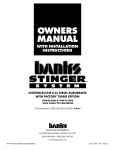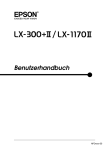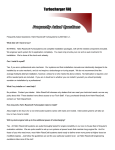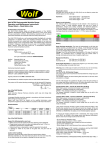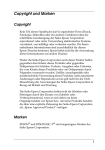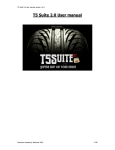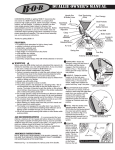Download Manual - Banks Power
Transcript
Owner’sManual with Installation Instructions Banks PowerPack® TLC™ System Including Stinger®-Plus tlc™ 1998-2002 Dodge 5.9L Cummins (24-valve) ISB Pickup Trucks THIS MANUAL IS FOR USE WITH SYSTEMs 49320-49335 & 49351-49356 Gale Banks Engineering 546 Duggan Avenue • Azusa, ca 91702 (626) 969-9600 • Fax (626) 334-1743 Product Information & Sales: (800) 438-7693 bankspower.com ©2009 Gale Banks Engineering 12/14/09 PN 96397 v.8.0 General Installation Practices Dear Customer, If you have any questions concerning the installation of your Banks Power system, please call our Technical Service Hotline at (888) 839-2700 between 7:00 am and 5:00 pm (PT). If you have any questions relating to shipping or billing, please contact our Customer Service Department at (888) 839-5600. Thank you. 1. For ease of installation of your Banks Stinger-Plus, or PowerPack system, familiarize yourself with the procedure by reading the entire manual before starting work. This instruction manual contains 26 pages of text, illustrations and parts listing. 2. Throughout this manual, the left side of the vehicle refers to the driver’s side, and the right side to the passenger’s side. 3. Disconnect the ground cable from the battery before beginning work. If there are two batteries, disconnect both. 4. Route and tie wires and hoses a minimum of 6 inches away from exhaust heat, moving parts and sharp edges. Clearance of 8 inches or more is recommended where possible. 5. When raising the vehicle, support it on properly weight-rated safety stands, ramps or a commercial hoist. Follow the manufacturer’s safety precautions. Take care to balance the 2 96397 v.8.0 vehicle to prevent it from slipping or falling. When using ramps, be sure the front wheels are centered squarely on the topsides; put the transmission in park; set the hand brake; and place blocks behind the rear wheels. Caution! Do not use floor jacks to support the vehicle while working under it. Do not raise the vehicle onto concrete blocks, masonry or any other item not intended specifically for this use. 6. During installation, keep your work area and components clean to avoid possible dirt entry into the engine. 7. For proper performance from your Banks PowerPack components and to prevent engine damage, it is essential that your engine’s fuel system be capable of delivering fuel at the factory’s specification. We have often found vehicles with inadequate low pressure side fuel delivery that isn’t apparent until performance modifications are made. It is very important that the following fuel system components are checked for proper operation before completing the installation. Notification The Banks Ram-Air Filter comes pre-oiled and no oiling is necessary for initial installation. Service the filter as specified in the Filter Maintenance Section of this manual. Tools Required: These tools are necessary for all levels of installation unless otherwise specified. • 1⁄ 4” and 3⁄ 8” drive ratchets with inch and metric sockets including 5⁄ 16”, 7⁄ 16” deep 1⁄ 4” drive sockets and a 1⁄ 4” drive extension Highly recommended tools and supplies (not applicable to all system levels): • Inch-pound and foot-pound torque wrenches • Inline fuel pressure test check valve fittings • Fuel pressure test gauge • Inch and metric combination or open-end wrenches • Compressed air source and hose • Standard and Phillips head screwdrivers • Rubber tipped air blow gun • Air pressure regulator • Standard and needle-nose pliers • Multimeter or 12-volt test light • Pocket or X-Acto knife • Penetrating oil or light lubricant spray • Clean shop towels or rags • Drill motor • Tap handle • 1⁄ 8” Allen wrench • 3⁄ 16” and 7⁄ 16” drill bits • 1⁄ 4” NPT tap • Heat gun (suggested) or cigarette lighter • Pry bar or large groove-joint (water pump) pliers • Wire crimping/stripping tool • Oxy-acetylene torch or reciprocating saw 96397 v.8.0 3 Checking Lift Pump Performance NOTE: Checking the lift pump performance is required before the installation of the your Banks performance product. Complete the following steps and check to see that the fuel lift pump is operating within specified parameters, otherwise damage to the fuel injection pump may occur. FUEL FILTER AND LINES If the fuel filter/water separator has not been recently replaced, it is highly recommended that this be done at this time. Check vehicle owner’s manual and factory service manual for replacement intervals and service procedure. FUEL TRANSFER (LIFT) PUMP The fuel transfer pump supplies fuel from the fuel tank through the fuel filter/water separator to the highpressure injection pump. It is a 12-volt vane-type self-priming pump mounted to the left side of the engine behind Figure 1 4 96397 v.8.0 the fuel filter/water separator. Check fuel lines to and from pump for leaks, kinks, or other restrictions. A pump with external housing leaks must be replaced. Clean the area around the pump and filter/separator before performing the following test. FUEL TRANSFER PUMP TEST If a factory service manual is available, refer to the Fuel Transfer Pump Test in the Fuel System portion of the manual. Otherwise perform the test as indicated. For ‘01-02 trucks, proceed to Step 3. 1. Remove the two hex plugs from the top of the fuel filter/water separator mount and replace them with two inline check adapter fittings. Use the fittings supplied in Banks part number 43910 test gauge kit or Parker part number AVU1-2 Access Valve, Male connector or equivalent. See Figure 1. 2. Install the included fuel pressure test gauge with appropriate hose Figure 2 fitting to the check valve installed in the inlet port of the fuel filter mount (This is the check valve farthest away from the engine). For ‘981⁄ 2-00 trucks, proceed to Step 5. 3. Remove protective cap from fuel pressure test port fitting. See Figure 2. Clean area around cap and fitting before removing the cap. 4. Install the included fuel pressure test gauge onto the fuel pressure test port fitting. 5. Prevent the engine from starting by removing the fuel injection pump relay in the Power Distribution Center. 6. Crank the engine and observe the fuel pressure. Cranking pressure should be 5-7 PSI. 7. Re-install the fuel injection pump relay in the Power Distribution Center. 8. Start the engine and check the pressure. It should be a minimum of 10 PSI at idle. NOTE: If a fuel pressure of 5-7 psi while cranking or 10 PSI with the engine idling is not observed, this may indicate the presence of a faulty Fuel Lift Pump. Replace the faulty Fuel Lift Pump or damage to the Fuel Injection Pump may occur. 9. If a Diagnostic Trouble Code was set when the pump relay was removed, use a scan tool to remove the trouble code. 10. ‘981⁄ 2-00 trucks only: Shut off the engine and switch the fuel pressure gauge from the inlet side check valve to the outlet side check valve (closest to engine). Start the engine and observe the pressure, it should be no more than 5 PSI lower than the inlet pressure previously recorded. If a greater pressure drop is observed, replace the fuel filter. Once the pressure test is complete, remove the check valves and re-install the hex plugs in the fuel filter mount. 96397 v.8.0 5 General Assembly Figure 3 Description 1 2 3 4 5 6 7 8 9 10 11 12 13 14 15 16 17 6 High-Ram® Inlet Casting Quick-Turbo® Turbine Housing Assembly Monster® T.O.P. (Turbine Outlet Pipe) Intermediate Pipe Extension Pipe (Extended-cab Only) Dynaflow® Muffler Monster® Tailpipe Tailpipe Tip Banks Ram-Air® Filter BigHead® Wastegate Actuator OttoMind® TLC Engine Calibration Module Wire Harness Thermocouple Leadwire, Thermocouple DynaFact® Boost Gauge DynaFact® Pyrometer Gauge Wire Harness, Gauge 96397 v.8.0 18 19 20 21 22 23 24 25 26 27 28 Two-gauge Mounting Panel Hanger Clamp 4” Exhaust Clamp (2) (extended-cabs, 3) 8” Stud (2) 83⁄ 8” Stud (2) 5⁄ 16-24 Nylock Nut (4) 5⁄ 16 AN Washer (4) Stat-O-Seal (4) Gasket, Inlet Casting Gasket, Turbine Inlet Urocal, “Banks Power” (3) 96397 v.8.0 7 System Installation Procedure EXHAUST REMOVAL 1. Under vehicle, remove the entire factory exhaust system. Starting at the rear of the vehicle, remove each component by either cutting through the pipe near the clamps or by removing the clamps and heating the joints to a red-orange color to allow the crimped pipes to separate. Remove the pin-type hangers from the rubber frame mounts by prying with a pry-bar or by pressing the pin out of the rubber with large water pump pliers. A soapy water solution or a penetrating lubricant will ease the removal of pin-type hangers from the rubber frame mounts. Remove the two bolts that attach the turbine outlet pipe to the turbine outlet elbow and remove the turbine outlet pipe from the vehicle. Keep these bolts for later use. To remove the turbine outlet pipe, it may be necessary to cut the pipe just to the rear of the pin hanger that slides into the hanger bracket on the transmission mount. TURBOCHARGER REMOVAL 2. Loosen the clamps that attach the air inlet tube to the air filter housing and to the turbocharger, and remove the air inlet tube from the vehicle. Remove the air filter housing from the vehicle. This will allow easier access to the turbocharger. nuts or bolts and the turbocharger from the exhaust manifold. CAUTION: Anytime the turbocharger is removed from the engine, take care that no foreign objects enter any of the turbocharger connections on the engine or the turbocharger. Foreign objects entering air, exhaust, or oil connections may cause major damage to the engine and/or turbocharger and is not covered under any warranty. Cover the open end of the intercooler pipe with a rag, as this pipe is very susceptible to foreign object entry. 6. Clean and inspect the exhaust flange mounting surfaces on the exhaust manifold. Make sure the surface is clean and dry. THERMOCOUPLE INSTALLATION 7. The thermocouple monitors the temperature of the exhaust gases entering the turbocharger at the turbine housing. Installation requires that the exhaust manifold be drilled near the outlet of the manifold adjacent to the turbine housing. For this reason it is essential that the turbocharger be removed from the engine in order to clean out any metal chips from drilling that could cause turbine blade damage. the turbocharger. The Cummins ISB engine uses a divided exhaust manifold and turbocharger. The thermocouple may be installed to sample exhaust temperature in either exhaust passage. We recommend the rear passage (toward the firewall). 5. Note the orientation of the 8. Stuff a small shop towel or rag 4 to 3. Loosen the upper hose clamp on the turbocharger oil drain-tube hose, located between the two sections of the oil drain tube. 4. Disconnect the oil supply hose at compressor housing in the vehicle. When the new assembly is installed the orientation of the compressor outlet should remain the same. Remove the turbocharger mounting 8 96397 v.8.0 5 inches into the rear exhaust manifold passage through the turbocharger mounting flange. This is to prevent chips from entering the manifold while drilling and tapping. 9. Drill through the exhaust manifold into the rear passage at the location shown in Figure 4. Use a 7⁄ 16” drill, keeping the drill perpendicular to the manifold surface. 10. Tap the drilled hole with a 1⁄ 4” NPT pipe tap. Check the thread depth as you tap by periodically removing the tap and screwing the thermocouple into the tapped hole. The thermocouple should thread in 3 Figure 4 96397 v.8.0 9 to 31⁄ 2 turns hand tight. Do not install the probe in place at this time. 11. Remove as many loose chips as back out. DO NOT use a thread locking compound as a substitute for peening the end of the tube. Thread locking compounds will become ineffective due to temperature. possible from the exhaust manifold. A shop vacuum, small brush or fingers will help. Now remove the rag using a welding rod or coat hanger bent into a hook. 16. Using the supplied #55 bit, drill a Caution! Make sure rags are removed from exhaust manifold prior to reinstalling turbocharger! 17. Reinstall the actuator on the 12. Install the thermocouple in the manifold using anti-seize on the threads. Note: At this point in the installation process, it is necessary to determine which model turbocharger your vehicle is equipped with. A turbocharger identification tag is located on the front of the compressor housing of the turbo or on the actuator. If your turbocharger is an HY35W, follow steps 13-17. If your turbocharger is an HX35W, proceed to step 18. ACTUATOR INSTALLATION/ MODIFICATION 13. Remove the E-clip from the wastegate arm, allowing the actuator rod to be released. Save the E-clip for reinstallation. Remove the two nuts holding the actuator to the compressor housing and remove the actuator. 14. Tap the end of the boost reference tube on the stock actuator with the supplied 1⁄ 4-28 UNF tap. Tap the tube just deep enough so that the end of the jet is recessed approximately 1⁄ 32” to 1⁄ 16” when threaded into the end of the boost reference tube and tightened until snug. 15. Install the jet into the end of the boost reference tube then peen the edge of the tube so that the jet cannot 10 96397 v.8.0 hole in the side of the boost reference tube close to the area where the tube is attached to the actuator can. compressor housing. Be careful not to damage the O-ring that seals the boost reference tube to the compressor housing. Next, reinstall the actuator rod end on to the wastegate arm. This will be difficult since considerable force is required to extend the rod far enough. Reinstall the E-clip. Proceed to step 23. TURBOCHARGER DISASSEMBLY and RE-ASSEMBLY 18. Remove the turbine discharge elbow by removing the five bolts around the backside of the turbo. 19. Clamp the turbine inlet flange of the turbocharger in a smoothjaw bench vise. Loosen the four bolts attaching the turbine housing to the center bearing section of the turbocharger. See Figure 5. 20. Remove the bolts, lock plates, and clamp plates. Carefully remove the center bearing and compressor assembly from the cast iron turbine housing. If the turbocharger has been in service for some time, rust and carbon may prevent the center bearing and compressor assembly from easily separating from the turbine housing. If light hammer blows, penetrating oil or heat will not free the compressor assembly from the turbine housing, the clamp bolt adjacent to the turbo oil inlet connection may be backed out so as to push against the bearing casting and separate the two components. Figure 5 Remove any loose rust or carbon from the bearing housing that might prevent proper engagement into the new turbine housing. 21. Install the center bearing and compressor assembly into the new turbine housing. Apply a dab of antiseize compound to the bolts, and then install bolts, clamp plates, and lock plates finger-tight to allow for final positioning. 22. Install the turbine outlet elbow onto the new turbine housing using the original bolts and the new gasket supplied. Install the center bearing and compressor assembly into the new turbine housing. Apply a dab of anti-seize compound to each of the bolts, and then torque the bolts to 100 in-lbs. Make sure the turbine inlet flange does not rotate in the vise while torquing. 96397 v.8.0 11 TURBOCHARGER INSTALLATION EXHAUST INSTALLATION 23. Note: Some turbos are mounted 27. Position the new Banks Monster Use the supplied 3⁄ 8-24 x 13⁄ 4” bolts and crimplock nuts for the upper holes on the turbine mounting flange. 28. Place a 4” muffler clamp onto the with four studs protruding from the exhaust manifold while others have two studs in the manifold and two in the factory turbine housing. Install the new turbine inlet gasket provided and apply a dab of anti-seize compound to the four turbo mounting studs. Install the turbocharger on the exhaust manifold. As the turbocharger is reinstalled, slip the oil drain tube into the drain hose. Tighten the turbocharger mounting nuts to 24 ftlbs. Tighten the oil drain hose clamp. Note: Before slipping any boost tubes and the corresponding hoses, into position, ensure that all connection ends are clean and free of any oil residue and contaminates. Clean compressor outlet and all connection points with a non-oil based solvent such as Acetone, Mineral Spirits, Denatured Alcohol or Lacquer Thinner. Read and follow the manufactures operation instruction for non-oil based solvent cleaner. 24. Align the compressor outlet with the intercooler hose adapter and tighten the clamp. Tighten the turbine housing clamp plate bolts to 100 inlbs. 25. Spin the turbocharger shaft to make sure it turns freely. If not, loosen the turbine clamp plate bolts and check for misalignment between the turbine housing and turbocharger center section. Retighten bolts and check again. 26. Reconnect and tighten the turbo oil supply hose. T.O.P. turbine outlet pipe onto the turbine outlet elbow. See Figure 3 on page 6-7. Install the attaching bolts to hold it in place, but do not tighten them yet. outlet of the turbine outlet pipe, and then slide the intermediate pipe into the hanger at the transmission mount, and onto the turbine outlet pipe. Note: on extended cab short bed models, it maybe necessary to shorten the intermediate pipe. Install the muffler and tailpipe without clamps and determine how much to trim based on the hanger position. 29. On extended cab/quad-cab long bed models only, position another 4” clamp onto the outlet end of the intermediate pipe, and install the extension pipe onto the intermediate pipe. 30. Install the muffler assembly onto the end of the extension or intermediate pipe. Temporarily support the muffler and install the hanger clamp at the front of the muffler. Snug the nuts, but do not fully tighten them. 31. At the rear of the muffler, slip a 4” clamp over the outlet of the muffler. Install the tailpipe up over the axle, and into the muffler outlet. Place the hanger pins into the rubber frame mounts behind the axle. Slip the 5” Monster tailpipe tip on. Keep the wrapping on until installation is complete. The tip should be rotated so the clamp nut is pointing down. Install the 5” tip so that it hangs past the end of the tailpipe by 1” for fleet-side trucks and 21⁄ 2” for duallies or where aesthetically pleasing. 32. Starting from the front of the vehicle, tighten all exhaust system attaching bolts and clamps. Make 12 96397 v.8.0 sure each slip joint is fully inserted, and that all frame mount hangers are hanging in a forward position. See Figure 6. For Stinger-Plus Installations, proceed to step 38. HIGH-RAM INSTALLATION 33. Disconnect the hose joint at the inlet end of the factory intake casting. Remove the dipstick tube retaining bolt from the inlet casting. Remove the wire loom clamp from the rear of the inlet casting. This may break upon removal from the casting; it is not reused. Remove the four bolts that mount the inlet casting to the intake manifold and remove the factory inlet casting. Note: at this point it may be easier to complete the OttoMind installation while the intake casting is off. Cover the opening in the intake manifold with a clean rag to prevent foreign object entry, and proceed to step 38. After you have completed step 54, return to step 34 34. Remove the front inboard bolt from the baseplate of the intake manifold. Loosen the nut on the ground strap for the intake heater element and rotate the cable around so that the ring terminal can be reinstalled under the head of the intake bolt. Important: do not allow the terminal on the element end of the ground cable to come in contact with the upper heater lug or with the injector line. Retighten the retaining nut and reinstall the front intake manifold bolt through the ring terminal. See Figure 7. 35. Thread the four studs provided into the intake casting, placing the shorter studs on the inboard side. Note: The end of the stud with the coarse thread goes into the intake manifold. Use Loctite sparingly on the threads. Using the two 5⁄ 16”-24 nuts provided, tighten the studs into the casting by threading both nuts onto each stud, tightening the nuts against each other using two 1⁄ 2” open end wrenches, and then tightening the Figure 6 96397 v.8.0 13 Figure 7 stud by turning the wrench on the top nut. Reverse the process and remove the nuts from the stud and then repeat on each remaining stud. See Figure 8. 36. Slide the intake gasket provided over the studs and set the High-Ram™ in place on the studs. Twist a Stat-oseal washer over each stud, followed by a flat 5⁄ 16” AN washer. Install a 5⁄ 16”-24 nylock nut on each stud and tighten all four evenly. Caution: Use only handtools when tightening the High-Ram. Tighten snugly but do not overtighten. Damage to the High-Ram casting can result from the use of pneumatic tools or excessive tightening. Note: Before slipping any boost tubes and the corresponding hoses, into position, ensure that all connection ends are clean and free of any oil residue and contaminates. Clean 14 96397 v.8.0 compressor outlet and all connection points with a non-oil based solvent such as Acetone, Mineral Spirits, Denatured Alcohol or Lacquer Thinner. Read and follow the manufactures operation instruction for non-oil based solvent cleaner. 37. On ‘981⁄ 2-00, models rotate the dipstick tube clamp as shown in Figure 8, then reinstall the dipstick tube bolt into the threaded boss provided. For 2001 models, a spacer bracket is provided. Mount it to the High-Ram casting using the original factory bolt. Fasten the dipstick tube bracket to the spacer bracket using the 5⁄ 16” nylock nut and bolt. Install the silicone inlet hose onto the inlet of the casting and tighten. The wire loom clamp is not reinstalled. OTTOMIND INSTALLATION 38. For automatic transmission models, locate and remove the rubber Figure 8 plug mounted in the firewall slightly above and to the right of the steering shaft, as viewed facing the firewall through the engine compartment. Make a cross-shaped incision in the plug and reinstall it in the firewall. See Figure 9. covering four black wires at the top back portion of the fuel injection pump. See Figure 10. For manual transmission models, make an incision in the main wiring loom grommet above the wire bundle. Take care to not cut any wiring. See Figure 9. 40. At the front of the intake Insert the black twist connector on the OttoMind wire loom provided through the grommet from the engine compartment side. 39. Locate the two black wire sheaths Caution: It is very important that you select the proper wire. The Banks OttoMind will not function properly if installed incorrectly. manifold, remove the three bolts holding the throttle bracket assembly to the head. Move this assembly toward the driver’s side battery. This will allow easier access to the fuel pump wiring. 41. Locate a black wire tap connector and a packet of dielectric grease in the Banks system. Squirt a generous 96397 v.8.0 15 Figure 9 amount of the grease into the connector and install the connector onto the wire identified in step 39 as shown in Figure 11. 42. Locate the Manifold Absolute Pressure (MAP) sensor on the intake manifold. Unplug the factory connector, and plug the corresponding connectors on the OttoMind wire loom into the sensor and the factory wire loom. See Figure 12. 43. Plug the corresponding male bullet connector on the wire loom to the installed connector on the pump. 44. Remove three Phillips-head screws from the trim panel below the steering column and remove panel by pulling directly toward the rear of the vehicle. Toward the right side of the 16 96397 v.8.0 opening, remove two Phillips-head screws and install the OttoMind as shown in Figure 13. 45. Plug the main connector from the wire loom into the OttoMind connector. Route all wiring away from any pedals or other moving components. Using the cable ties supplied, secure the wiring under the dash. Reinstall the trim panel. Secure all wiring under the hood away from heat sources or sharp edges. For manual transmissions the blue wire will be unused and may be cable tied out of the way. 46. Remove the forward bolt on the fuel filter mounting bracket. Install the ring terminal of the ground wire under the head of the bolt and reinstall the bolt. See Figure 12. Figure 10 47. Locate the gray Throttle Position Sensor (TPS) connector just above the injection pump. Unplug the connector and plug both ends into the corresponding connectors on the OttoMind wire loom. See Figure 12. Note: For manual transmission applications, proceed to Step 53. 48. On automatic transmission models, locate the PCM (rectangular metal box with three connectors mounted on the passenger’s side of the firewall) in the engine compartment. See Figure 14. 49. Make sure that the ignition is off, then disconnect all three connectors from the PCM for easier accessibility to the wires. 50. Select the center (white) connector and locate the wire in the No.11 connector pin cavity. This will typically be an orange wire with a black 96397 v.8.0 17 Figure 11 tracer stripe. Install a T-Tap connector on this wire approximately 2-3 inches from the white connector body. 51. Plug the three cable connectors back into the PCM. The connector bodies are indexed so they cannot be installed in the wrong location. 52. Locate the long blue wire emerging from the middle of the Banks OttoMind wire loom. Route this wire with the factory wire loom across the base of the cowl and over to the PCM. Plug the wire into the T-Tap installed on the No.11 pin wire at the center PCM connector. 53. Reinstall the throttle bracket and bolts removed earlier. Tighten to 18 ft-lbs. Reinstall the air filter housing on the turbocharger. Iinstall the Banks 18 96397 v.8.0 Ram-Air filter. 54. Route the thermocouple leadwire through the grommet in the firewall. Connect the yellow and red wires of the leadwire to the corresponding connectors on the thermocouple. Plug the remaining end into the proper port on the OttoMind. DYNAFACT INSTRUMENTATION INSTALLATION 55. Choose a suitable location under the lower edge of the dash panel for mounting the instrument panel provided where the driver can conveniently view it. This will typically be above and slightly to the right of the accelerator pedal. Figure 12 96397 v.8.0 19 Figure 13 Figure 14 20 96397 v.8.0 Note: Molded instrument consoles for top-of-dash or pillar mount and additional gauges are available through Gale Banks Engineering. c. Strip one end of the BLACK wire and crimp it to the butt connector containing the BLACK wires from step ‘a’. 56. Using the panel as a template, d. Route the RED wire to the fuse box. Locate the appropriate fuse for instrument lighting in the owner’s manual. Cut the RED wire as required and strip the end. Crimp the push on connector to the RED wire and connect to the fuse as shown in Figure 15. Alternatively, locate power wire to dimmer switch and install T-tap. Cut the RED wire as required and strip the end. Crimp the push on T-tap connector to the RED wire and connect to T-tap on dimmer power wire. drill two 3⁄ 16” diameter holes in the dash and mount the panel with two No. 10 x 1⁄ 2” machine screws, nuts and star washers provided. 57. Locate the gauge wire loom with the four wire connector in the Banks system. Plug the connector into the corresponding location on the OttoMind box. Route the wire loom from the OttoMind box toward the gauges location. 58.Install the DynaFact boost and pyrometer gauges in the mounting panel using the clamps and thumbnuts provided. Plug the BLACK wire lead to the male spade terminal on the BLACK wire of each gauge wire harness. Plug the YELLOW wire into the Yellow wire of the boost gauge wire harness and the RED wire into the RED wire of the pyrometer gauge wire harness. The ORANGE wire remains unused. 59. Connect the 4-pin connector of each gauge into the back of its corresponding gauge. a. Crimp the remaining Black and RED wires from each 4-pin connector gauge harness to the butt connectors as shown in Figure 15. b. Strip one end of the RED wire and crimp it to the butt connector containing the RED wires from step ‘a’. e. Locate a metal surface that will serve as an acceptable chassis ground. Cut the BLACK wire to a sufficient length that will allow it to reach the chassis ground and strip the end. Crimp the ring terminal to the BLACK wire as shown in Figure 15. f. Drill a 1⁄ 8” hole, if required, to attach the ring terminal to the chassis ground. Caution: If drilling, check the backside to make sure there are no components that may be damaged by drilling. g. Use the supplied self-tapping screw to secure the ring terminal to the chassis ground 96397 v.8.0 21 Figure 15 22 96397 v.8.0 Checking Engine Performance Go over the entire installation as a precautionary check to ensure that all clamps are tight, wiring and hoses are properly routed, and connections are tight. Start the engine and allow it to warm up. Drive the vehicle under light load (normal around-town driving) for 20 to 30 minutes, and listen for any exhaust leaks or rattles, or intake boost leaks. Shut off the engine and re-tighten all intercooler and turbocharger boost clamps. These connections may have loosened with time, and if leaking, will cause a drop in boost pressure with a loss in performance. Check that clamps are properly positioned on hoses, and periodically check tightness of hose clamps at regular maintenance intervals, such as when the oil is changed. Observe the operation of the boost and pyrometer gauges while driving under varying conditions. Turbocharger boost pressure will increase as a function of load and engine RPM, thus the engine will produce little boost while cruising at light throttle, with maximum boost while climbing hills heavily loaded during acceleration. Note the boost level seen during hard acceleration with a given load. If performance seems to have deteriorated sometime in the future, the maximum boost figures may be compared to see if boost has dropped off. Lower boost may be caused by turbo ducting leaks, a malfunctioning wastegate or fuel injection pump, or dirty air filter. Typical maximum boost pressure settings for the Dodge/ Cummins diesel will vary considerably with stick or automatic transmission options, year model of vehicle and altitude. Use your pyrometer gauge to monitor exhaust gas temperature (EGT) in the engine. At idle, exhaust gas temperature will be very low, perhaps only 300°F. As the engine is accelerated for higher speeds with greater loads, the EGT will rise. The highest EGT will be seen under maximum load at full throttle, such as climbing a steep grade with a heavily laden vehicle. Your pyrometer is color coded to assist in your reading of the gauge. The red zone indicate a dangerous level of temperature. Your engine should not operate in this range for more than a few seconds. The blue zone indicates when it is safe to shut the engine off. To avoid heat damage to various engine components it is recommended that the exhaust gases cool below 400º before the engine is shut down. Your OttoMind is calibrated to maintain a maximum EGT of 1300°F. You may experience brief excursions slightly above 1300°F under acceleration. This is normal and EGT should return to at or below 1300° within a few seconds. If you find that EGT remains high for any length of time, check for boost leaks or a dirty air filter. If you feel that your OttoMind is not functioning properly, some diagnostics can be performed. Remove the OttoMind from its mounting location while keeping all three connectors plugged in. Observe the two LED’s mounted on the programming port. The upper left LED will indicate red when the key is on. Once the engine is started and idling, the red LED will go out and the upper right LED will indicate green. As load increases, the red LED will progressively grow brighter as fuel delivery is increased. If LED’s do not indicate as suggested check all connections to ensure that they are proper. 96397 v.8.0 23 Filter Maintenance Notification The Banks Ram-Air Filter comes pre-oiled and no oiling is necessary for initial installation. Service the filter as specified in this Section of the manual. 1. Service Banks Ram Air Filter every 50-100,000 miles on street-driven applications. Service more often in off-road or heavy-dust conditions. If an air-filter restriction gauge is installed, then clean the element when the air-filter restriction gauge enters the restrictive red zone. See Figure 45. 2. Use Banks Ram Air Filter cleaning system (part # 90094), available from Gale Banks Engineering to service the Air Filter. Follow the instructions included with the cleaning system to clean and re-oil your Banks Ram Air Filter. No gasoline cleaning, No steam cleaning, No caustic cleaning solutions, No strong detergents, No high pressure car wash, No parts cleaning solvents. Any of these No’s can cause harm to the cotton filter media plus SHRINK and HARDEN the rubber end caps. CAUTION! Extremely fine dust from agriculture or off-road use will pull the oil from the element. Frequent re-oiling of the element’s clean side might be required. Completely service when practicable. For extra protection use an air-filter sealing grease on rubber ends of the element. Service only with Banks Ram-Air-filter cleaner and Banks Ram-Air-filter oil. Figure 45 Typical air-filter restriction gauge AIR-FILTER RESTRICTION GAUGE RESTRICTIVE RED ZONE 24 96397 v.8.0 Notes 96397 v.8.0 25 FIG #1 1 2 3 4 5 6 7 8 9 10 11 12 13 14 15 16 17 18 19 20 20 21 22 23 24 25 26 26 COMPONENTstinger-plus CASTING, High-Ram Inlet ASSEMBLY, Turbine Housing, Quick-Turbo® PIPE, Turbine Outlet PIPE, Intermediate PIPE, Extension(Extended cab only) MUFFLER, Banks Dynaflow® PIPE, Monster® Tailpipe Tailpipe Tip FILTER, Banks Ram-Air® ACTUATOR, BigHead® OTTOMIND®, Engine Calibration Module HARNESS, Wire THERMOCOUPLE LEADWIRE, Thermocouple GAUGE, Boost GAUGE, Pyrometer HARNESS, Gauge Wiring PANEL, Two-gauge Mounting KIT, Service, Banks Ram-Air Filter CLAMP, Hanger (2) CLAMP, 4” Exhaust (Std. Cab) (3) CLAMP, 4” Exhaust (Ext. Cab) HOSE, Silicone KIT, Wiring, Gauge Lighting CONNECTOR, Wire tap (2) BOLT, 3⁄ 8 - 24 x 13⁄ 4” HEX (2) STUD, 8” (2) STUD, 83⁄ 8” (2) NUT, 3⁄ 8 - 24 Collet Lock Nut (4) NUT, 5⁄ 16 - 24 Nylock (2) NUT, 5⁄ 16 - 24 Standard (2) WASHER, 3⁄ 8 A.N. (4) WASHER, 5⁄ 16 A.N. (4) STAT-O-SEAL (2) CLAMP, Spring Band GASKET, Inlet Casting 96397 v.8.0 -- 3 3 3 3 3 3 3 3 -- 3 3 3 3 3 3 3 3 3 3 3 3 3 3 3 3 -- -- 3 -- -- 3 -- -- 3 -- POWERPACK 3 3* 3 3 3 3 3 3 3 -3 3 3 3 3 3 3 3 3 3 3 3 3 3 3 3* 3 3 3* 3 3 3* 3 3 3 3 FIG #1 27 28 COMPONENTstinger-plus GASKET, Turbine Inlet GASKET, Turbine Outlet TAP, 1⁄ 4”-28 Plug (2001 235 HP Model Only) DRILL BIT, #55 (2001 235 HP Model Only) JET, Actuator Tube (2001 235 HP Model Only) ANTI-SEIZE LOCTITE GREASE, Dielectric (15) TIES, 8” Cable (6) TIES, 8” Cable OWNERS MANUAL WARRANTY STATEMENT, 5 year WARRANTY STATEMENT, 2 year WARRANTY STATEMENT, 1 year (3) UROCAL, Banks Power DECAL, Do Not Discard CARD, Product Registration *Except system #49334,49335, 59353 and 49354 3 3 -- -- -- 3 --- 3 3 -- 3 3 3 3 3 3 3 POWERPACK 3 3* 3 3 3 3 3 3 3 -3 3 3 3 3 3 3 96397 v.8.0 27 Gale Banks Engineering 546 Duggan Avenue • Azusa, ca 91702 (626) 969-9600 • Fax (626) 334-1743 Product Information & Sales: (800) 438-7693 bankspower.com




























